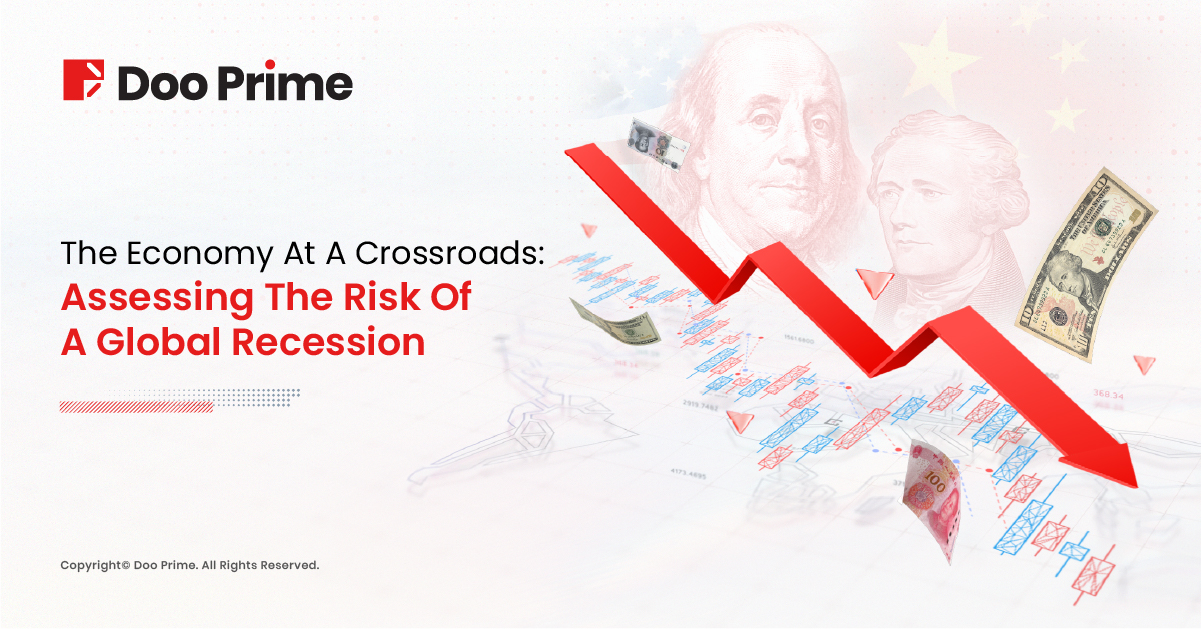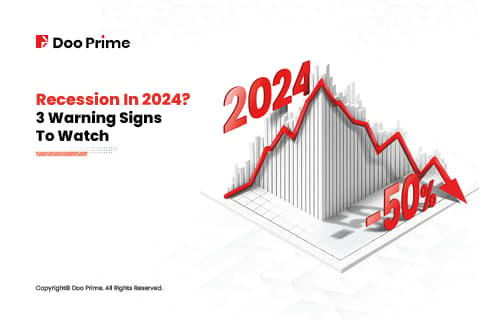
In recent years, the global economy has faced numerous challenges and uncertainties. The outbreak of the COVID-19 pandemic, trade tensions between the United States and China, conflicts such as the Russia-Ukraine war, and the Federal Reserve’s aggressive interest rate hikes have raised concerns of an impending global recession.
These events have caused market anxieties, leading to a decline in consumer confidence and insufficient expansion momentum for businesses. Issues such as production halts and bankruptcies have also emerged. Additionally, high global debt levels and inflationary pressures continue to pose threats to economic stability. And recently, even Elon Musk, one of the world’s richest men, took to social media to voice his concerns about an upcoming mild recession.
With the economic chill permeating every corner of the globe, it begs the question: is a major global recession inevitable? Moreover, in the face of this impending economic downturn, how should investors adapt their strategies? This article aims to explore these pressing questions and provide insights for investors navigating recessionary pressures.
Global Institutions’ Forecasts: Gloomy Economic Prospects

In early April of this year, the World Bank estimated that global Gross Domestic Product (GDP) growth would fall below 2% for the year, rise to 3% by 2024, and then slow down to 2.2% by 2030, well below the average growth rate of 3.5% in the first decade of this century.
Similarly, the International Monetary Fund (IMF) warned in its latest World Economic Outlook that current economic growth is at historical lows, financial risks are increasing, and the prospects for economic recovery are weaker than expected.
While central banks in the United States and Europe, led by the Federal Reserve, have pursued tight monetary policies in recent years to mitigate inflation, the high interest rates have punctured asset bubbles and triggered shocks in interest rate risk, as exemplified by the crisis in the U.S. banking sector. The IMF predicts that the global economy will enter a period of weakness as investment and production activities slow down.
Furthermore, the Organisation for Economic Co-operation and Development (OECD) has made its own forecasts, projecting global economic growth rates of 2.6% for this year and 2.9% by 2024. This is largely attributed to the gradual recovery of China and India, the two populous nations, in the post-pandemic era, which offsets the sluggish growth momentum in Europe and the United States.
Meanwhile, considering the U.S. efforts to decouple economically from China, it is likely to increase its own economic costs. Lawrence Summers, former U.S. Treasury Secretary, believes there is a 70% chance of the U.S. entering an economic recession this year.
Challenges In The Face Of Global Recession: Limited Solutions

In summary, the persistently high interest rates since the significant rate hikes by the U.S. and Europe have had adverse effects on global economic development. However, with the escalating crisis in the U.S. banking sector, the Federal Reserve began injecting USD 300 billion liquidity into the banking system as early as March this year.
The recent hits from the Federal Reserve’s meeting suggest that the interest rate hike in May might be the last one this year. Consequently, markets have begun speculating that countries in Europe and America may resort to quantitative easing (QE) measures to relax monetary policies and maintain financial and economic stability.
Nevertheless, this raises new concerns as quantitative easing has always been a double-edged sword and not a permanent solution to economic difficulties. Since the previous financial crisis in 2008, the G7 countries have embarked on quantitative easing, which brought relative economic stability to developed economies for over a decade. However, it has also led to higher debt levels and fueled speculative asset bubbles. Moreover, it has shifted investors’ focus from long-term investment strategies to short-term profit chasing.
Furthermore, the implementation of QE has had profound implications, leading to significant structural changes in the global financial system.
One of the primary effects of QE is the substantial expansion of central bank balance sheets within the G7 group. Since 2008, these balance sheets have tripled in size, skyrocketing from USD 5.7 trillion to a staggering USD 23.5 trillion by 2020.
Concurrently, the United States’ Net International Investment Position (NIIP), which represents the difference between a country’s external assets and liabilities, has witnessed a deteriorating trend in the QE era.
The NIIP-to-GDP ratio serves as a measure of a country’s financial creditworthiness, with a higher negative ratio indicating greater vulnerability to volatility in international financial markets. By 2020, the U.S. found itself indebted to the rest of the world by USD 14.7 trillion more than what it was owed—a stark contrast to the USD 4 trillion imbalance in 2008.
Moreover, the United States is grappling with heavy debt burdens within the current imbalanced financial system. Consequently, several nations, including China, Russia, and Brazil, have recognized the inherent risks associated with the U.S. dollar and are increasingly turning to their own currencies for trade settlements.
The United States, as a representative of developed economies, is already experiencing a recessionary period. Similarly, China, a prominent developing country, is also witnessing a slower economic recovery than initially anticipated.
During China’s recent Golden Week, the nation recorded a significant increase in travelers, with 274 million people embarking on journeys—an impressive 70.83% YoY rise. The tourism revenue amounted to 148.056 billion yuan, reflecting a remarkable YoY growth of 128.90%.
While these figures may appear promising at first glance, a closer analysis reveals a notable decline in average travel expenditure. Dividing the travel revenue of 148 billion yuan by the 274 million trips yields an average travel expenditure of 540 yuan per person, whereas pre-2019 epidemic data indicated a figure of approximately 640 yuan per person. This discrepancy underscores a discernible “lipstick effect” in the current Chinese economy, signifying a decline in consumer demand.
Preparing For Economic Uncertainty: The Importance Of Investor Preparedness

The global economy is facing economic challenges, both in developed and developing countries, with the possibility of a global recession on the horizon. The G20 group responded to the 2008 financial crisis with stimulus packages, such as China’s RMB 4 trillion plan, equivalent to 12.5% of its GDP.
While quantitative easing (QE) measures were implemented in Europe and the United States, it is important to recognize that QE has shown short-term benefits but also carries inherent long-term drawbacks, providing only temporary solutions. Furthermore, the current international political landscape is more intricate than in 2008, with increasing decoupling between major powers.
In light of these circumstances, investors should consider diversifying their portfolios to include safe-haven assets like gold. This strategic move serves a dual purpose: seeking a safe-haven effect during uncertain times and pursuing other investment objectives.
To successfully navigate the challenges ahead and emerge stronger from a potential global recession, it is crucial for governments and central banks to carefully evaluate the long-term consequences of their monetary and fiscal decisions. Businesses and investors must remain vigilant and adapt their strategies to the uncertainties ahead.
By taking proactive measures and implementing prudent policies, it is possible to overcome the challenges and foster a more stable and sustainable global economy. The World Bank, IMF, and OECD have all emphasized the need to address the risks associated with the current economic climate.
In conclusion, the road ahead requires a delicate balance of stimulating growth while avoiding excessive debt accumulation and asset bubbles. With careful consideration and foresight, we can navigate these economic challenges and emerge stronger, ensuring a brighter future for the global economy.
| About Doo Prime
Our Trading Products
Securities | Futures | Forex | Precious Metals | Commodities | Stock Indices
Doo Prime is an international pre-eminent online broker under Doo Group, which strives to provide professional investors with global CFD trading products in Securities, Futures, Forex, Precious Metals, Commodities, and Stock Indices. At present, Doo Prime is delivering the finest trading experience to more than 90,000 clients, with an average trading volume of more than USD 51.223 billion each month.
Doo Prime entities respectively holds the relevant financial regulatory licenses in Seychelles, Mauritius, and Vanuatu with operation centers in Dallas, Sydney, Singapore, Hong Kong, Dubai, Kuala Lumpur, and other regions.
With robust financial technology infrastructure, well-established partnerships, and an experienced technical team, Doo Prime boasts a safe and secure trading environment, competitive trading costs, as well as deposit and withdrawal methods that support 20+ different currencies. Doo Prime also incorporates 24/7 multilingual customer service and extremely fast trade execution via multiple industry-leading trading terminals such as MT4, MT5, TradingView, and Doo Prime InTrade, covering over 10,000 trading products.
Doo Prime’s vision and mission are to become a financial technology-focused broker, streamlining international global financial products investment.
For more information about Doo Prime, please contact us at:
Phone:
Europe: +44 11 3733 5199
Asia: +852 3704 4241
Asia – Singapore: +65 6011 1415
Asia – China: +86 400 8427 539
E-mail:
Technical Support: [email protected]
Account Manager: [email protected]
Forward-looking Statements
This article contains “forward-looking statements” and may be identified by the use of forward-looking terminology such as “anticipate”, “believe”, “continue”, “could”, “estimate”, “expect”, “hope”, “intend”, “may”, “might”, “plan”, “potential”, “predict”, “should”, or “will”, or other variations thereon or comparable terminology. However, the absence of such terminology does not mean that a statement is not forward-looking. In particular, statements about the expectations, beliefs, plans, objectives, assumptions, future events, or future performance of Doo Prime will be generally assumed as forward-looking statements.
Doo Prime has provided these forward-looking statements based on all current information available to Doo Prime and Doo Prime’s current expectations, assumptions, estimates, and projections. While Doo Prime believes these expectations, assumptions, estimations, and projections are reasonable, these forward-looking statements are only predictions and involve known and unknown risks and uncertainties, many of which are beyond Doo Prime’s control. Such risks and uncertainties may cause results, performance, or achievements materially different from those expressed or implied by the forward-looking statements.
Doo Prime does not provide any representation or warranty on the reliability, accuracy, or completeness of such statements. Doo Prime is not obliged to provide or release any updates or revisions to any forward-looking statements.
Risk Disclosure
Trading in financial instruments involves high risks due to the fluctuation in the value and prices of the underlying financial instruments. Due to the adverse and unpredictable market movements, large losses exceeding the investor’s initial investment could incur within a short period of time. The past performance of a financial instrument is not an indication of its future performance. Investments in certain services should be made on margin or leverage, where relatively small movements in trading prices may have a disproportionately large impact on the client’s investment and client should therefore be prepared to suffer significant losses when using such trading facilities.
Please make sure you read and fully understand the trading risks of the respective financial instrument before engaging in any transaction with Doo Prime’s trading platforms. You should seek independent professional advice if you do not understand any of the risks disclosed by us herein or any risk associated with the trade and investment of financial instruments. Please refer to Doo Prime’s Client Agreement and Risk Disclosure and Acknowledgement Notice to find out more.
Disclaimer
This information is addressed to the general public solely for information purposes and should not be taken as investment advice, recommendation, offer, or solicitation to buy or sell any financial instrument. The information displayed herein has been prepared without any reference or consideration to any particular recipient’s investment objectives or financial situation. Any references to the past performance of a financial instrument, index, or a packaged investment product shall not be taken as a reliable indicator of its future performance. Doo Prime and its holding company, affiliates, subsidiaries, associated companies, partners and their respective employees, make no representation or warranties to the information displayed and shall not be liable for any direct, indirect, special or consequential loss or damages incurred a result of any inaccuracies or incompleteness of the information provided, and any direct or indirect trading risks, profit, or loss arising from any individual’s or client’s investment.



